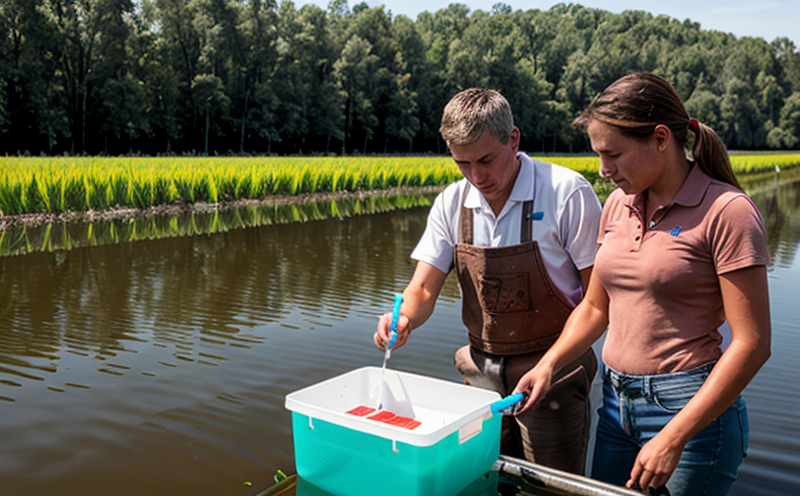Barium Content Testing in Irrigation Water
The testing of barium content in irrigation water is a critical component of ensuring soil and plant health. Barium is an alkaline earth metal that, while essential in small quantities for certain plants, can be harmful in higher concentrations. Excessive levels of barium can disrupt the balance of nutrients in the soil, affecting the absorption capabilities of crops. This imbalance can lead to stunted growth, reduced yields, and even plant death.
Water used for irrigation should meet specific quality standards set by international bodies such as ISO 14025. These standards provide guidelines on how to conduct testing that ensures accurate results and reliability. In the case of barium content, the permissible levels are typically defined in parts per million (ppm), with a maximum concentration depending on the crop type.
The testing process begins with proper sample collection. Water samples should be taken from various points around the irrigation system to ensure an accurate representation of the overall water quality. Once collected, these samples undergo rigorous preparation techniques such as filtration and dilution to ensure they are suitable for analysis. The use of appropriate laboratory equipment is essential; this includes pH meters, conductivity meters, and specific ion selective electrodes.
The primary analytical method used for barium content testing in irrigation water is atomic absorption spectroscopy (AAS). This technique measures the absorption of light by atoms in a gaseous state, allowing for precise quantification. Other methods include inductively coupled plasma mass spectrometry (ICP-MS) and ion chromatography, which offer high sensitivity and accuracy.
The results from these tests are crucial for determining whether the barium levels fall within acceptable limits. If concentrations exceed recommended thresholds, corrective actions must be taken. These may involve adjusting the water source or implementing additional treatment processes to reduce barium content. Regular monitoring is necessary to maintain compliance with regulatory requirements and best practices.
In summary, accurate barium content testing in irrigation water plays a vital role in sustaining agricultural productivity while minimizing environmental impact. By adhering to established standards and using advanced analytical techniques, laboratories can provide reliable data that supports informed decision-making processes within the industry.
Benefits
Conducting barium content testing offers numerous benefits for those involved in agriculture and forestry. One of the key advantages is enhanced crop quality and yield. By ensuring that irrigation water contains appropriate levels of barium, farmers can prevent nutrient imbalances which could otherwise hinder plant growth and development.
Another significant benefit lies in improved soil health. Excessive amounts of barium can negatively affect the structure and fertility of soils, leading to reduced overall productivity. Regular monitoring helps maintain optimal conditions for sustainable farming practices.
Compliance with regulatory requirements is another important aspect addressed through thorough testing. Governments around the world have set limits on permissible levels of various contaminants in agricultural waters based on scientific evidence about their effects on both human health and ecosystems. Ensuring adherence to these regulations not only protects public welfare but also promotes responsible business practices.
Lastly, implementing robust quality assurance measures contributes significantly towards building trust among consumers who value environmentally friendly products derived from responsibly managed farmlands. Such transparency fosters better relationships between producers and end-users, ultimately contributing positively to brand reputation.
Industry Applications
The application of barium content testing extends beyond just agriculture; it also plays an integral part in forestry management. In this context, monitoring barium levels helps maintain healthy forests by ensuring that the water used for irrigation does not introduce harmful concentrations into soil and vegetation.
For instance, when planting new trees or reforesting degraded areas, it is essential to ensure that the water supply meets all necessary criteria. This includes checking for barium content as well as other potential contaminants like nitrates and heavy metals.
In addition to its direct role in sustaining plant life, accurate testing can help prevent damage caused by secondary effects of barium presence such as increased acidity or alkalinity levels in the soil. These changes can impact not only tree health but also affect surrounding wildlife habitats.
Furthermore, compliance with international standards like ISO 14025 ensures that forestry operations are conducted sustainably and ethically. This certification provides assurance to stakeholders about the integrity of practices employed during forest management activities.
Competitive Advantage and Market Impact
In today’s competitive market, having access to reliable and precise barium content testing services can give agricultural businesses a significant edge over their competitors. By providing accurate data on water quality, these services enable producers to make informed decisions regarding irrigation practices.
A company that offers top-tier testing capabilities demonstrates its commitment to maintaining high standards of environmental stewardship. This dedication resonates well with consumers increasingly concerned about sustainability and ethical sourcing. Thus, it becomes easier for such companies to build stronger customer relationships and gain market share.
Moreover, compliance with international standards not only enhances a company’s reputation but also opens up new opportunities for collaboration and expansion into other regions where similar regulatory frameworks are in place. As global awareness about environmental issues grows, the demand for sustainable agricultural practices is expected to continue rising, creating favorable conditions for businesses offering advanced testing solutions.





